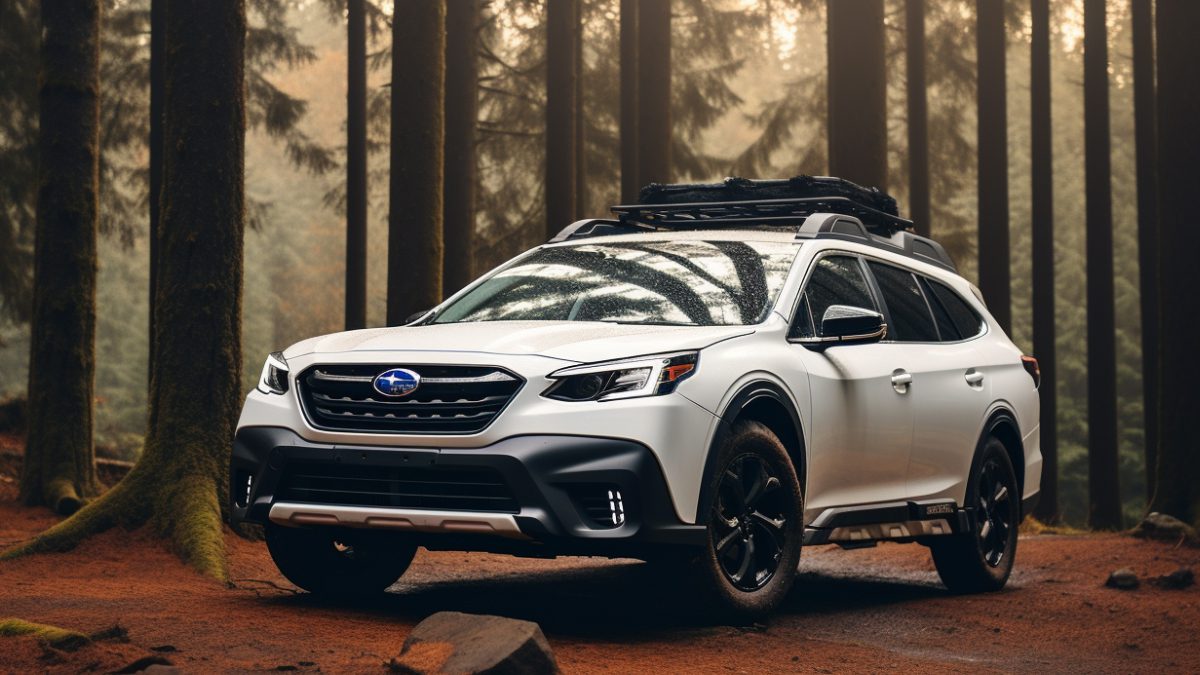Subaru Outback ABS Warning Light On: Reasons and Resetting Tips
You own a Subaru Outback, and on the dashboard, the ABS warning light pops. This is concerning because it indicates issues with your ABS system. Ultimately, this can pose a safety risk when you drive your Subaru Outback.
To address the issue promptly, knowing the underlying reasons is crucial. The reasons for this problem are as follows.
- The low level of brake fluid
- A faulty ABS module
- Malfunctioning wheel speed sensors
- Worn-out brake pads
- ABS pump issues
- Faulty ABS solenoid
- Faulty ABS ring
- Damaged wiring
- Corroded grounding
- Electrical issues.
Read on as we’re going to guide you through the common reasons for the Subaru Outback ABS warning light ON and how you can tackle them.
Subaru Outback ABS Warning Light ON: 10 Reasons Described
The ABS is a highly sophisticated mechanism that prevents wheel locking and slipping under harsh braking conditions. According to a 2013 peer-reviewed study, it reduces the rate of road accidents by up to 40%.

Now, in a Subaru Outback, some particular malfunctions can stop the ABS from working properly and cause the warning indicator light for your ABS to turn ON.
What are these? Let’s find out:
1. Faulty Wheel Speed Sensors
The ABS in the Subaru Outback uses speed sensors on each wheel. Wheel speed sensors monitor the rate at which your wheels are spinning. They provide vital data to the ECU. It then calculates whether to decrease or increase the braking pressure on each wheel.
If these sensors become damaged or dirty, they can send inaccurate readings, causing the ABS light to turn on. Wheel speed sensors can fail due to various reasons, such as debris buildup, physical damage from rough terrain, or even simple wear and tear over time.
2. Damaged ABS Module
The ABS module (with the ECU and the HCU) is essentially the brain and the heart of the ABS. The ECU processes data from the wheel speed sensors, and the HCU then modulates brake fluid pressure to prevent wheel lock-up.
However, these components are prone to failure over time. It happens usually due to prolonged heat exposure or internal short-circuiting.
As supported by a 2014 study report, a malfunctioning ABS module cannot control the brake-fluid pressure effectively and compromises the ABS function. So, if the ABS module is faulty, your ABS warning light will come on.

3. Inadequate Brake-fluid Amount
The brake fluid of your Subaru Outback transmits the force you apply on the brake pedal to the brake calipers. Thus, it facilitates wheel deceleration.
If your brake fluid is low, it tells you there is a leak in your vehicle hardware system. It can also mean that you have worn brake pads, and they have been drawn in more fluid to maintain braking performance.
In such cases, not only will the caution light for your ABS activate, but you may also notice a decrease in braking effectiveness.
4. Worned-out Brake Pads
Worned-out brake pads can also cause the caution light for your ABS to come on. It’s because they increase the brake fluid demand, decreasing the fluid level in the reservoir.
The Subaru Outback is typically equipped with brake pad wear indicators. They should produce a high-pitched squeal when the pad’s life is nearing its end.

5. Electrical Issues
Your Subaru’s electrical system has multiple types of wirings and fuses. So, a blown fuse, frayed wires, or poor connections can also trigger the ABS warning light.
These issues can result from age, wear and tear, or even damage by house rodents. It requires a thorough electrical diagnosis by a qualified technician to identify and fix the problem.
6. Malfunctioning ABS Pump
The ABS pump is a part of the hydraulic control unit. It is crucial to keep the brake-fluid pressure consistent throughout your vehicle’s braking system.
Therefore, a malfunctioning ABS pump can cause an imbalance, which the ECU detects, leading to the ABS light becoming illuminated. A failing ABS pump might also generate an abnormal noise while the ABS is in operation.

7. Worn Out or Incorrectly Installed ABS Rings
ABS rings, or reluctor rings, are part of your vehicle’s CV joints (Constant-velocity Joints). They are critical for sending correct speed data to the ABS system.
If they become worn out or are incorrectly installed, it can cause desynchronization in the readings between the wheels. And this results in the ABS light turning on.
8. Faulty ABS Solenoids
ABS solenoids are located within the ABS module. These control the release and hold function for the brake fluid that travels to each brake caliper.
Over time, these solenoids can become sticky, or they entirely fail, leading to the ABS light illuminating.
9. Corroded Ground Connections
Corrosion at ground connections can cause electrical resistance, and it affects the ABS system’s operation.
This resistance can interfere with the ECU’s ability to communicate with the ABS components. Thus, it leads to the illumination of the ABS warning light.

10. Aged or Damaged Wiring Harness
The wiring harness is responsible for connecting various parts of the ABS. This can become damaged or deteriorate due to age, environmental factors, or physical damage.
If the wiring harness is compromised, it will lead to the ABS light coming on, as well.
Subaru Outback ABS Warning Light on: (DIY Solutions)

Let’s delve into the practical solutions to the potential causes we’ve already outlined:
1. Addressing the Faulty Wheel Speed Sensors
Your first task is to identify which sensor is faulty. An OBD-II scanner tool can be invaluable here.
According to a 2018 research published by IEEE, one of the most effective ways to diagnose ABS light problems is by using an OBD-II (On-board Diagnostics II) scanner.
Therefore:
- Plug it into your car’s OBD-II port (usually located under the steering wheel).
- It will display error codes pointing to the affected wheel.
- Once you’ve pinpointed the faulty sensor, you’ll need to remove the wheel for access.
- The sensor is usually located near the brake disc and is held by a single bolt.
- Now, remove the bolt, disconnect the electrical connector, and replace it with the new sensor.
- Then, reconnect the wire and bolt it back into place.
2. Replacing the Damaged ABS Module
Replacing the ABS module is a more complex task.
- For your own protection, detach the cable connecting the battery’s negative terminal to the battery.
- Then, locate your ABS module – it’s typically found in the engine bay. It’s identifiable by the brake lines running into it.
- Disconnect the electrical connections and brake lines.
- Then, unbolt the module from its mounting bracket.
- Install the new module by reversing the removal process.
Then comes the critical part: bleeding the brake system. For this,
- You’ll need to remove air from the system. To do this, have another person press the brake pedal for you.
- Meanwhile, you have to open and then close the bleed screws on each brake caliper.
- Start doing this from the caliper that is furthest from the ABS module.
Once completed, clear any fault codes using an OBD-II scanner.
3. Refilling Inadequate Brake-fluids
The fluid should be between the MIN and MAX lines. Any deviation requires you to pay immediate attention. Refilling brake fluid is relatively straightforward. All you need to do is just:
- Get under the hood and find the brake-fluid reservoir.
- To add the proper fluid (typically DOT3 or DOT4 for Subaru Outbacks), unscrew the reservoir cap and unscrew the fill plug.
- Fill it until it reaches the MAX mark.

4. Replacing Worn Brake Pads
If you detect that warning light and the high-pitched squealing sound at the same time, replace the brake pads immediately. Replacing brake pads is a common DIY task. Just do the following stuff:
- Start by jacking up your car and removing the wheels.
- Locate the brake caliper and unbolt it, then slide out the old brake pads.
- Next, push back the brake piston using a piston wind-back tool or C-clamp.
This step is necessary because new brake pads are thicker than worn-out ones.
- After that, insert your new brake pads, bolt the caliper back on, and replace the wheel.
- Repeat this process for both sides of the car.
5. Fixing Electrical Issues
For simple electrical issues, like a blown fuse, refer to your Subaru Outback owner’s manual for the correct fuse type and its location in the fuse box.
Then, use a fuse puller or needle-nose pliers to remove the blown fuse and install the new one.
If your issue is related to a bad ground connection, locate the grounding points in your car (refer to your vehicle’s wiring diagram).
Then, using a wire brush, clean the grounding points and the terminal ends to ensure a good connection.

6. Solving ABS Pump and Solenoid Problems
Unfortunately, replacing the ABS pump or solenoids is not a feasible DIY task due to the risk involved.
These components are integrated into the ABS module, and their replacement involves high-pressure systems and intricate electrical work.
So, you must seek professional help for this.
7. Replacing ABS Rings
If you hear noises from your ABS pump and see the warning light simultaneously, replace the ABS pump ASAP. Replacing ABS rings is a relatively complex task. But, with our guided steps below, it will definitely feel easy for you:
- To get to the axle or CV joint, you will need to take apart the brake caliper and rotor after you take off the wheel.
- Once the axle is exposed, the ABS ring can be replaced.
- Make sure to install it correctly, aligning the teeth with the sensor.
- Lastly, reassemble the components in reverse order.
8. Repairing the Wiring Harness
You can repair a damaged wiring harness with minimal electrical knowledge. Just consider doing the following:
- Using a multimeter, find the issue in the harness by checking for continuity between different points.
- Once identified, you can fix a frayed wire by stripping the insulation, twisting the wires together, and then insulating it with electrical tape.
- For more severe damage, the whole wire segment will need to be replaced.

9. Cleaning Corroded Ground Connections
Cleaning corroded ground connections involves:
- Detaching the connection,
- Scrubbing away corrosion using a wire brush,
- Then, reattaching it.
Note: Applying a small amount of dielectric grease in this step will help prevent future corrosion.
How to Reset the Subaru Outback ABS Warning Light?

Here are some methods for resetting the ABS warning light on a Subaru Outback. You have to follow the below tips after doing the repairs as we have instructed in the above section:
- After the ABS system is repaired, disconnect the battery for 15 minutes. This will clear the fault code that triggered the light.
- For some Subaru models, you have to hold down the brake pedal and turn the ignition key to ON (not starting the engine) for 10 seconds. This can also reset the ABS warning light.
- Driving the car for a while after any repairs may also help reset the light. The ABS system has to go through a drive cycle to clear the fault codes.
FAQs
Let’s check out some common queries related to the Subaru Outback ABS light issue:
You may be able to drive. But do it with caution. It’s because, in certain hard braking situations, your wheels could lock up, leading to loss of steering control.
Subaru recommends replacing brake fluid every 30,000 miles or 24 months, whichever comes first. Always use high-quality DOT 3 or DOT 4 brake fluid, as specified in your Subaru owner’s manual.
While there’s no set lifespan, ABS control modules often last the life of the vehicle. That’s as long as 2 to 3 decades. However, water damage, corrosion, or electrical issues can cause premature failure.
A simple sensor replacement might cost between $100 and $200. But replacing an ABS control module will run between $600 and $1,000.
Conclusion
In the case of the Subaru Outback ABS warning light ON issue, you have to remember that each issue requires its unique approach. So, not all solutions will apply to every situation.
Hence, what you have to do is identify the cause first, followed by a systematic approach to the fix (by following our guide above).
Best of luck in your DIY automotive journey with your Subaru Outback. But, yet, if you are not comfortable with fixing the issues, please consult a professional auto mechanic.

